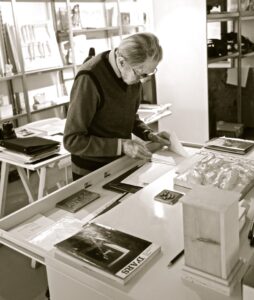 Benedetto Pietrogrande (1928-2019)
Benedetto Pietrogrande (1928-2019)
Benedetto Pietrogrande was born in Montegalda (Vicenza) il 19 November 1928.
He studied at the Art High School in Venice and then attended the Academy of Fine Arts with Venanzo Crocetti (1913-2003) than in 1946 he had succeeded Arturo Martini on the chair of sculpture.
Pietrogrande in turn became a teacher at the Venice Academy as soon as he finished his studies. In the fifties he began to participate in competitions, reviews and exhibitions of young artists, in particular those promoted by the Bevilacqua La Masa Foundation. His studio is on Giudecca in the "Tre oci" house, frequented at the time by artists such as Primo Conti, Carlo Scarpa, Roberto Ferruzzi, Friedensreich Hundertwasser, Gregorio Sciltian, Ilse Bernheimer.
At the beginning of the 1960s, he followed with intense participation the epochal event represented by the Second Vatican Ecumenical Council to which he dedicated numerous emblematic bas-reliefs. Later he moved to Milan, where in 1964 if you have, at the San Fedele Gallery, one of his first solo shows. In Milan he will become the holder of the chair of plastic disciplines at the Brera artistic high school, dedicating himself more and more exclusively to sculpture and to the public and private commissions that have followed one another over the years.
To the cultural references belonging to his training in the Venetian period (the study of classical and Byzantine art; the postwar debate on realism and abstractionism; the interest in the human figure according to the lessons of twentieth-century masters such as Henry Moore, Marino Marini, Alberto Giacometti) new stimuli are added in contact with the Milanese environment. The strong instances of social renewal that emerge close to the 1968, together with a constant search on a spiritual level, they take him to frequent the citadel of the Pro Civitate Christiana in Assisi, laboratory in those years of lively cultural experiments, where he will hold a solo show.
It is in the seventies, in a climate of contestation, that Pietrogrande develops his po-ethics, closely linked to an existential dimension, which he strives to express, beyond the social denunciation, the dignity of man through everyday objects that become symbols. The series of "saddlebags" and "suitcases" are born, alluding to themes dear to him such as the phenomenon of immigration (which he observes in the frequent journeys between Milan and Venice) and the "wrecks" that allude to the Vietnam War.
In the eighties and nineties the evolution of his plastic language passes through the "evictions"
and the "memories": compositions made with elements of abandoned furniture intended as traces, of human events observed with empathy. It is the representation of the drama of the precariousness and fragility of the human condition, but always combined with a message of hope expressed by the dynamism of the forms. The depth of the contents overcomes the distinction between sacred and non-sacred art, so much so that in parallel with these researches Pietrogrande continues to devote himself to the religious subject.
As for monumental works, the first important commission is John XXIII ordered by the Municipality of Corsico in 1973. They will follow: Monument to Giulio Natta, Ferrara 1980; Peace Monument, Figino 1983; Peace Monument, Grisignano 1986; Monument to St. Michael the Archangel, Monza 2004; Statue of N.S. of Fatima, Fatima 2008.
His creations are born with the aim of harmoniously inserting themselves in the places where they are arranged with the intent not so much to "monumentalize" the spaces but to "humanize" the environments. For this reason it often works in collaboration with architects, convinced of the importance of the relationship between sculpture and space. Many of his productions are born from a shared planning harmonizing the reciprocal languages: this is the case of his interventions in the churches of Romano di Lombardia (1979), by Cadine (1990), of Blackboard cables (1990-1991), of Milano Due (1992), of Dragoncello-Rome (2000). With equal commitment, he inserts new solutions in old churches while respecting the context (for example: pre-Romanesque basilica of Santa Maria Assunta in Calvenzano, Vizzolo Predabissi 1997; pre-Romanesque chapel of the Anaunian Martyrs in the basilica of San Simpliciano, Milan 2005; church of Santa Maria alla Fonte, Milan 2013). The sculptural intervention at the basilica of San Giuseppe al Trionfale in Rome is also located in this direction (2013) where he inserted ten bronze bas-reliefs on the pre-existing wooden door.
For several years he was a member of the Commission of Sacred Art for the Diocese of Milan.
In the 2015 a large retrospective is dedicated to him at the Diocesan Museum in Milan.
He died in Milan on 5 marzo 2019.
Present since the 60s in many art exhibitions: Biennial Bronzetto (Padua), Biennial Sculpture (Palazzo della Permanente - Milan), "Sacred Art in S. Simpliciano”(Milan), Biennale di Arese (Villa Reale in Monza).
He has held solo exhibitions and group exhibitions at the gallery-Bevilacqua La Masa in Venice, Gallery D. Fedele in Milan, Center S. Michele di Cremona.
He participated, among other, exhibitions "S. Paul in Contemporary Art "(Braccio di Carlo Magno, Vatican City – 1977) and "Pope Paul VI, a light for art " (Museum of the Duomo in Milan / Vatican Museums – 1999).
It 'won first prize in the National competition for the sculpture "Giovanni Tavani" in 1989.
His works are in public and private collections, such as the Gallery of Contemporary Art of the Pro Civitate Christiana di Assisi, the Paolo VI Contemporary Art Collection of Concesio (BS), the Diocesan Museum of Milan and the Vatican. He also made monumental tombs in the cemetery in Milan and other cities of Italy.
They spoke of him: Bernardini, Cookies,,it,Nicoletti,,en, Boccardi, Bonometti, Brevini, Brugnaro, Carluccio, Minassian, Monteverdi, Nicoletti, Peduzzi, Perocco, Raboni, Scazzoso, Scheiwiller, Severi.
